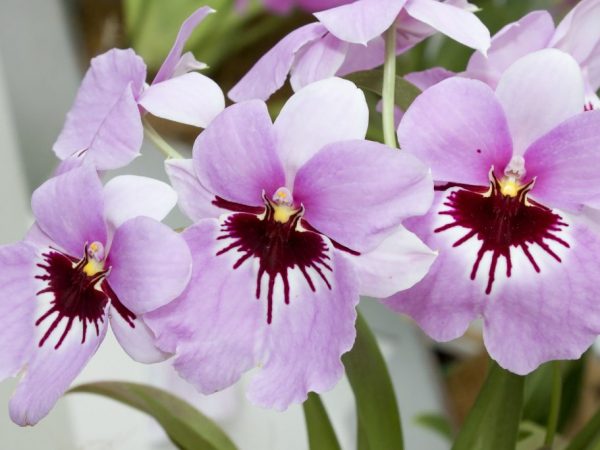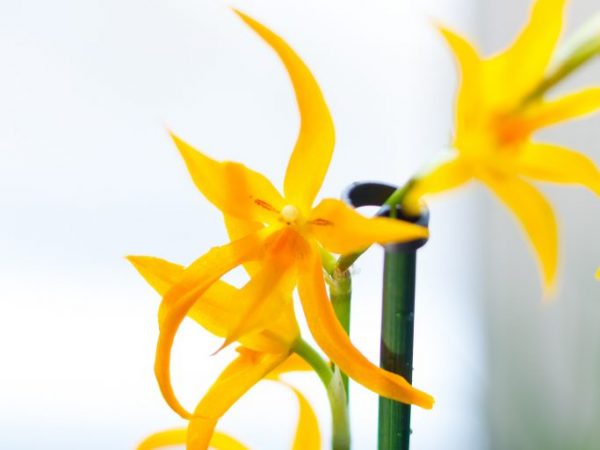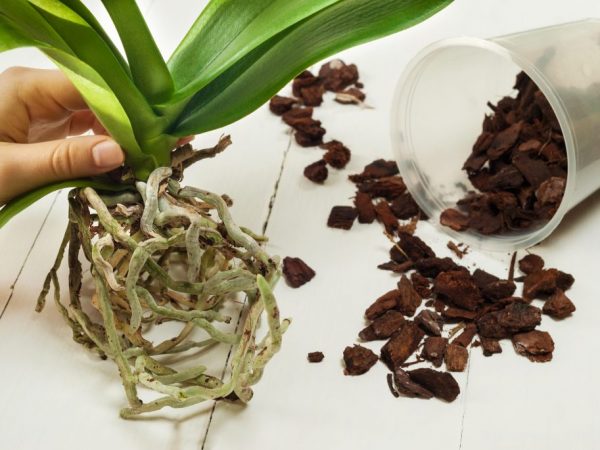Features of growing Miltonia orchids
Miltonia Orchid is a perennial that grows both in the wild and at home, native to South America (Brazil, Argentina). The flower is named after Viscount Milton (an English grower and orchid collector). There are about twenty species of this variety. Growing a beautiful and healthy plant requires special care.
- Orchid description
- Varieties
- Miltonia is snow-white
- Renelli
- Miltonia brilliant
- Miltonia wedge-shaped
- Miltonia yellowish
- Miltonia Clos
- Miltonia Varshevich
- Miltonia Sunset
- Growing
- Watering
- Air humidity
- Air temperature
- Illumination
- Priming
- Top dressing
- Pruning
- Transfer
- Reproduction
- Wintering
- Care errors
- Diseases and pests
- Conclusion

Miltonia Orchid
Orchid description
Miltonia is the generic name for many hybrids, including Miltoniopsis (a hybrid from Ecuador). Plants are epiphytes. This means that they can take root on other trees or flowers. Moisture is obtained from the air.
The flower has many hybrids that are formed both naturally (in natural conditions) and artificially (breeders combine different species to get new varieties). There can be several parents. For example, Miltoniopsis moth looks like two flowers at once - Pansies and Phalaenopsis.
It is not difficult to grow Millioniopsis, the conditions are the same as for any other variety.
In Miltonia, near the root system, there are pseudobulbs in the shape of an oval (length from seven to eight centimeters, width from four to five centimeters).
External description of the species:
- green pointed leaves (35-40 cm);
- flowers can be of different colors (10-12 cm);
- has a pleasant aroma during the flowering period;
Varieties
Miltonia is snow-white
Sympodial, has small flattened pseudobulbs (about 6 cm). Leaves are of an elongated sharp shape (about 30 cm).
Peduncles reach half a meter in length, one pseudobulb bears two peduncles, each of which blooms up to five large flowers.
The color is yellow with brown spots. The name is given because of the snow-white border on the lip.
Renelli
The leaves are long and pointed. A maximum of 7 flowers are formed on one peduncle, which have a pleasant smell. The flower is white with a pink border.
Features of the view:
- the number of flowers is from 3 to 7;
- the lip has different shades (from purple to pale pink);
Miltonia brilliant
Originally from Venezuela, the bulb is oval flat in shape up to 9 cm. The color of the leaves is light green. Peduncle (20-26 cm) has 1-2 flowers.
The color is white, cream, with a purple lip. It blooms for about a month, from August to October.
Miltonia wedge-shaped
This variety from Latin sounds like Miltonia cuneata. Bulbs are oval, narrowed. About 6 flowers grow on one peduncle, diameter is 7 cm.
The flowers are yellow, the petals are wavy at the edges, the smell is pleasant, delicate, not very pronounced. The border is white with purple dots. Flowering occurs in February and March.
Miltonia yellowish
In the wild, this subspecies is found in Paraguay, Argentina and Brazil. In Latin, the plant is called Miltonia flavescens.Pseudobulbs - yellow in color, oval flattened shape. The leaves are long (about 30 cm), green or yellow-green in color.
The peduncle reaches 1 m, and bears 15 flowers (up to 8 cm in diameter), yellow in color. The lip is white with purple stripes at the ends.

Yellowish Miltonia
Miltonia Clos
Bulbs have an oval, narrow and flattened shape (up to 10 cm long). It blooms throughout the year, except for December, February and March.
On a peduncle (60 cm), from 7 to 10 flowers grow, each one unfolds in turn. The diameter of the inflorescences is from 5 to 10 cm, they are close to each other. The color is amber, with brown spots, the shape is sharp. The lip is white with purple inserts on the edges.
Miltonia Varshevich
Florists appreciate this variety for its large inflorescences, the name was given in honor of Joseph Warsiewicz (gardener of the botanical garden in Krakow). The color of the flowers is brown and burgundy, the petals are wavy, have cream inserts. Border - pink with white edging and a bright spot in the center.
It blooms for a year and a half, if wilted flowers are removed according to the rules. Flowering begins at the beginning of spring and ends in the fall of next year.
Miltonia Sunset
Miltonia Sunset is a hybrid mix of two other species. The flowers are large, the smell is strongly pronounced fruit and berry.
The flowers are bright yellow, with overflow. Plant care is the same as for other Miltonia species.
Growing
You need to take care of Miltonia at home carefully. Before planting, determine where the plant will be. It should be well lit, but not in direct sunlight. Florists are advised to choose the western and eastern parts of the apartment. For the south side, use blinds or curtains.
This species feels comfortable in moderately warm and humid climates. Like any orchid variety, Miltonia does not tolerate drafts and temperature changes.
Watering
Miltonia orchid is native to the tropics, so it requires abundant and regular watering, especially during warm seasons. Water Miltonia up to 5 times a week. Florists advise to pay attention to the pallet - water should not stagnate in it.
Do not overflow the flower so that the root system and pseudobulbs do not rot. In winter, water 3-4 times a week. During this period, it is worthwhile to closely monitor the plant; during the dormant period, do not water at all.
Track how long it takes for the soil to dry out after watering. If more than 36 hours - the substrate is dense, but should be more airy. This indicates a low air temperature.
Air humidity
Air humidity is an important development indicator. It should be above 60-70%. If the leaves of the Miltonia orchid curl up, this indicates a lack of moisture.
Increase the amount of moisture using a container of water, which is placed near the flower. Another way is to spray water near the flower, it is important that drops do not fall on the plant itself.
Air temperature
The optimum air temperature is 20-22 ° С during the day, 15 ° С at night.
In summer, in hot weather, flower growers are advised to increase the air humidity. This will help the orchids feel more comfortable, even at the highest temperatures. Ice cooling can be achieved by placing the cubes near the bottom tray.
Illumination
Orchid Miltonia comes from warm places, but still prefers to be in partial shade. The main sign that the plant lacks light is dark leaves, and too much sun can cause burns.
Priming
Plastic transparent containers with drainage holes are suitable for growing, this will help not to retain moisture. Florists put stones or pieces of bark at the bottom of the pot. After that, the soil for Miltonia is filled up.
Another feature is the special primer that is sold in the store. It is possible to cook it yourself, the content should contain bark, fern root, peat and foam.

Soil for Miltonia orchid
Top dressing
Fertilizers are used regularly to keep the orchid healthy and blooming. The appearance of the plant will tell about its condition, about the lack or excess of this or that substance.
Soil nutrient content:
- nitrogen - with a shortage of leaves, lethargic, marbled, quickly dry out; in excess, it grows quickly, but does not bloom;
- copper - with a shortage of leaves of different shapes, there is no flowering; excess - the leaves have a red tint, the flower does not grow;
- phosphorus - if it is not enough, the plant is faded and weak, there is no flowering; in excess, the leaves darken at the tips;
- potassium promotes better metabolism and photosynthesis, if there is little of it in the plant's body, the leaves become dark with a yellowish tint; if there is a lot, the flow of nitrogen is blocked;
- calcium - if there is little of this substance, then the tissues are sluggish and weakened; if there is an excess, new shoots are deformed;
- magnesium - with a shortage, yellow spots appear on the foliage, which darken; with an excess, potassium deficiency occurs;
- iron - if the edges of the leaves die off, grows slowly, spots appear, this indicates a shortage; with an excess, development is dulled, and there is no flowering;
- zinc - helps in the synthesis of chlorophyll and enzymes, in practice there are only a few cases when it is not enough; if there is a lot of zinc, the leaves become marbled, deformed, and the flowers do not appear.
Pruning
The first sign that it's time to cut Miltonia is the wilting of the flowers. It is better to remove the shoots completely (leave a couple of millimeters) on which the flowers were located.
It is undesirable to use ordinary scissors for trimming; it is worth purchasing a special pruner or a sharp knife.
Transfer
Transplanting Miltonia at home occurs in the spring, at which time new seedlings appear. For a flower, this procedure is difficult to tolerate, so the regularity is once every 2 years.
A flower is transplanted when it becomes cramped in a pot. Transplant time - after flowering.
The plant is pulled out and placed in a container with warm water, the root system is washed and checked for rotten and unhealthy ones. They are removed. Sprinkle the place of cutting with sulfur or coal.
After that, the roots are dried if the air temperature in the apartment is high - 2-3 hours. Florists dry the root system at night, then all the cut will have time to heal.
For transplant, choose a pot slightly larger than the previous one. The container must be disinfected.
Do not transplant the plant immediately after purchase, the flower must adapt (7-10 days).
Reproduction
Reproduction of Miltonia usually takes place during the transplant in the spring. Reproduction occurs by dividing the bush. For this, 3-5 stems are used, the plant must be healthy.
The seedling is placed in a pot with a prepared substrate. The root system is planted shallow so that the roots do not rot.
Miltonia has practically no children, they rarely appear, so this breeding method is the most effective.
Wintering
As soon as the flower has bloomed, usually in winter, Miltonia goes into a state of sleep. Cut off all the dried-up shoots at the root, the main thing is not to harm the pseudobulba.
The rest period lasts 2 months. At this time, put the pot with the plant in a cool place (15-18 ° C), watering infrequently. This period ends when shoots begin to grow.
Care errors
Caring for Miltonia at home is not easy, many novice florists make a number of mistakes. Such mistakes can lead to a lack of flowering, and even the death of the plant.
Typical care problems:
- unopened flowers disappear - the reason is dry air, high temperature and draft;
- the flowering period is short - direct rays hit the plants, lack of minerals, high air temperature, short wintering period;
- leaves turn yellow - roots rot, or excess / lack of substances;
- the tips of the foliage dry out - dry air and salinization of the earth;
- light, white spots on the leaves indicate burns from direct sunlight;
- small black spots - stagnant water;
- dark foliage - little lighting, if light - overabundance;
Diseases and pests
If you take care and take care of an orchid, then diseases are rare.
There are diseases that cannot be treated: leaf spot (elongated spots, leaves turn yellow and darken), bronzing foliage (leaves become of different shapes, dark color, and become stained), bacterial, brown rot. In other cases, resuscitation for an orchid is possible.
Miltonia is affected by the same parasites as other varieties of orchids. Dry air is the main reason for their appearance ..
Conclusion
Miltonia Orchid is a gorgeous orchid variety that has more than 20 species, including hybrids. Caring for a flower is difficult, but adhering to certain conditions, the plant will decorate the home of any grower.
If the first signs of the disease appear, it is important to make a diagnosis in time so as not to kill the plant. The reasons can be different - from an inappropriate climate to a lack of substances. With good care, the orchid blooms all year round.


